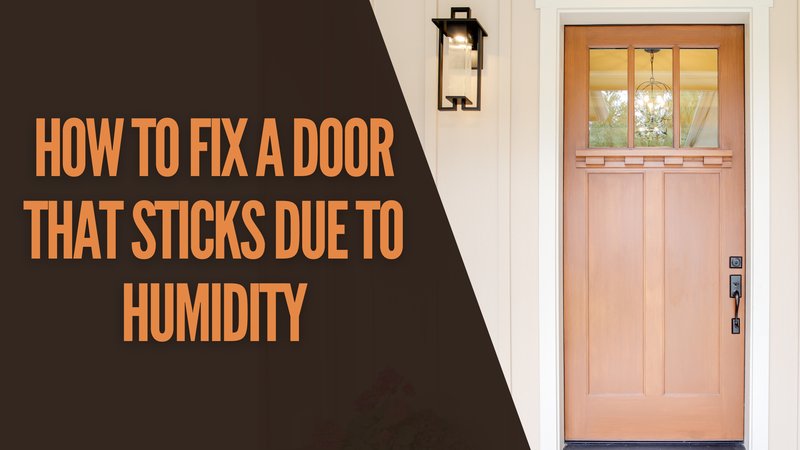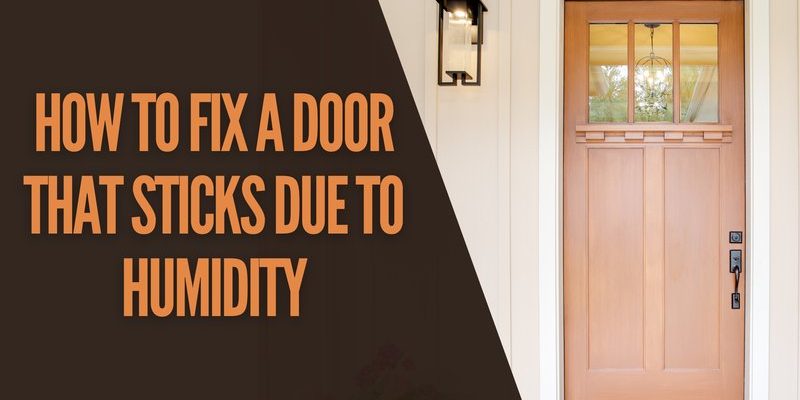
Here’s the thing: *humidity* and wood go together about as well as socks and puddles. When the air gets damp, wood in your door can absorb moisture and expand, making everything fit together a little too tightly. If you’ve got a classic wood exterior door—whether it’s from a big brand like Therma-Tru, Masonite, or a local hardware store’s own line—humidity doesn’t really care about the logo. It just sees an open invitation to mess with your entryway. The result? A sticky, stubborn door that tests your patience every time you come or go.
But why does this happen, and what can you actually *do* about it? Let’s walk through what’s really going on when your exterior door starts getting stuck on the frame as the humidity rises.
How Humidity Affects Wood Doors
Wood is like a living sponge, even after it’s been cut, sanded, and turned into a beautiful door. When the air gets humid, all those tiny wood fibers soak up moisture. Honestly, you might not see it happening, but you’ll definitely feel the results. The door swells, and every little millimeter counts—the whole thing can grow just enough to scrape the edges of the frame or even get wedged in place.
Let me explain why this is so common. Most exterior doors have minimal space between the door slab and the frame—what’s called the “reveal.” This gap is supposed to be just big enough to let the door swing smoothly but small enough to keep out drafts. Add swelling from humidity, and suddenly your perfect fit turns into a sticky mess.
Some wood species, like pine or fir, are more prone to swelling than others (mahogany is a bit more stable, for example). Even if your door’s painted or sealed, moisture can still sneak in through tiny cracks or unfinished edges. Paint and sealant help—but in areas with wild humidity swings, that’s often not enough to stop the swelling completely.
Why Steel and Fiberglass Doors Get Stuck, Too
You might be wondering, “Wait, what if my exterior door isn’t wood? Can steel or fiberglass doors get stuck on the frame because of humidity?” Actually, yes—just in a slightly different way.
Steel and fiberglass doors don’t soak up water the way wood does, so they won’t really swell. But here’s the catch: the wooden frame *around* the door—and sometimes even the *core* of those doors—can absorb moisture. So even if your door isn’t swelling, the frame might be shifting or changing shape, messing up how everything lines up.
In older homes, you might have a steel door on a wood jamb, or a fiberglass door with a wood frame. All it takes is a steamy week for the humidity to sneak in, making the wood swell and the door scrape or stick. It’s sneaky, but it happens a lot more often than people think. And if your door has a wood core beneath the steel or fiberglass skin, the same swelling rules apply inside, too.
Common Signs Your Door Is Stuck Because of Humidity
How do you know if humidity is really the culprit behind your sticky door? There are some telltale signs to look for—some obvious, some a bit more subtle.
- New scraping or sticking: If your door used to open smoothly and now it feels like it’s dragging or jamming on the frame, especially during wet seasons, humidity is a likely cause.
- Changes with the weather: Doors that stick mostly after a rainstorm or on muggy days but behave fine when it’s dry are often reacting to moisture in the air.
- Visible swelling: You might notice the door looks slightly warped, or you can see fresh rub marks on the edge or bottom.
- Harder to lock or latch: If the deadbolt or handle suddenly doesn’t line up or won’t click into place as easily, swelling may have shifted the alignment.
Sometimes the symptoms come and go—classic “humidity code.” If everything works in winter but jams up in summer, those moisture levels are probably changing what fits where.
Why Gaps and Weatherstripping Matter
You might not think much about the thin gap around your door or the squishy weatherstripping along the edge, but these details can make a *huge* difference when humidity comes into play.
If the gap between your door and frame is too tight, there’s no wiggle room for swelling. It’s a bit like buying shoes that fit perfectly in the store, but then your feet swell on a hot day and suddenly they’re pinching. Well-installed doors usually leave a small, even gap—just enough to let the door move without letting in drafts or rain. If the installer was a little too precise, or if paint or caulk has narrowed that gap over time, your door’s more likely to get stuck when the air gets damp.
Weatherstripping can also get compressed or shift over the years. If it’s old, torn, or bunched up, that alone can make the door sticky. In some cases, the weatherstripping itself *absorbs* moisture and swells, making the fit even tighter.
Simple Fixes for a Stuck Exterior Door
When your door’s stuck and it’s clearly caused by humidity, the fix isn’t always as drastic as replacing the whole thing. Sometimes, you can make things better with a few simple tweaks.
- Tighten or adjust the hinges: Check if screws have loosened or if the door has sagged. Sometimes, just tightening the screws or adding longer ones can help lift the door away from the frame a bit.
- Sand or plane the edges: If the swelling is minor and you can see exactly where the door rubs, you can carefully sand or plane a tiny bit off those spots. Just don’t overdo it! Remember, when the air dries out, the gap will grow again.
- Dehumidify: Running a dehumidifier near the entryway can help dry out the air (and the wood). This is a temporary fix, but sometimes it’s all you need to ride out a humid week.
- Replace or fix weatherstripping: If the weatherstripping is waterlogged or bunched up, swap it out for fresh strips designed for exterior doors.
If you have a painted or stained door, check for cracks in the finish—these let in moisture. Touch up paint or sealant as needed, focusing on the edges and bottom (the spots that usually get missed).
When To Call In a Pro
Sometimes, your best DIY efforts just aren’t enough. Here’s when it makes sense to call a pro:
- Major warping or splitting: If the door is badly bowed, cracked, or feels weak, it may be beyond a simple fix.
- Repetitive sticking: If the problem keeps coming back year after year, even after you sand or adjust, there may be a bigger installation or structural issue.
- Issues with the frame: If the frame itself is shifting, rotting, or separating from the wall, that’s a bigger job than most homeowners want to tackle.
A professional carpenter or door installer can check if the door was hung correctly, if the frame has moved, or if there’s hidden damage you can’t see. They can also rehang or re-square the door, which sometimes means resetting the hinges, shims, or even replacing parts of the frame.
How To Prevent Door Sticking In Humid Weather
You can’t control the weather, but you *can* make some moves to keep your entry door swinging freely all season. Here’s how to outsmart humidity before it starts causing trouble:
- Keep the door sealed: Regularly check and reapply paint or sealant to all six sides—yes, even the top and bottom edges. Unsealed spots are sneaky entry points for moisture.
- Maintain good airflow: Make sure your home isn’t trapping extra moisture by using exhaust fans, venting dryers outdoors, and occasionally cracking a window.
- Install a storm door: Adding a storm door creates a buffer zone, keeping some humidity away from the actual door surface.
- Choose stable door materials: If you’re replacing your door, ask about engineered wood, composite, fiberglass, or solid core options—they’re less prone to swelling than plain softwood.
Honestly, a little routine maintenance goes a long way. Setting a calendar reminder to check your door finish once or twice a year can save you a major headache later.
When Is It Time To Replace The Door?
Sometimes, no matter what you do, your exterior door just keeps clinging to the frame like it’s afraid of the outside world. If that’s the case, you might be better off looking for a replacement—especially if the wood is rotting, split, or so warped that it’s letting in drafts or water.
Modern doors come with all sorts of upgrades, like composite cores, better weatherstripping, and built-in adjustments that let you tweak the fit. You can even find pre-hung doors that include a new frame, eliminating a lot of the typical humidity headaches.
When shopping for a replacement, pay attention to these details:
- Material: Fiberglass, steel, and engineered wood are all good picks for resisting humidity and weather changes.
- Factory finish: Factory-applied paint and sealant are usually more durable than what you can do at home.
- Fit and installation: A properly fitted pre-hung door will have the right gap and sturdy hardware. Don’t skimp on installation—it’s just as important as the door itself.
If you’re set on keeping that classic wood look, just know that a little extra care (and maybe some seasonal sanding) will be part of the deal.
Closing Thoughts: Don’t Let Humidity Boss Your Door Around
Managing a sticky exterior door in humid weather is a rite of passage for homeowners—but it doesn’t have to drive you crazy. Once you know how humidity makes wood swell, why even steel or fiberglass doors can get stuck, and which simple fixes work best, you’re back in control. Keep an eye on the gap, stay on top of maintenance, and don’t be afraid to call in pro help if needed.
At the end of the day, your front door should welcome you home, not greet you with a wrestling match. With a little know-how and a dash of patience, you can keep your entryway smooth and stress-free—no matter what the weather’s doing outside.
